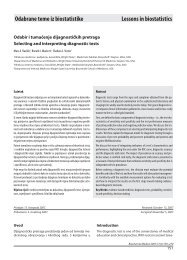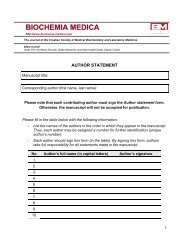Posterske teme Poster topics - Biochemia Medica
Posterske teme Poster topics - Biochemia Medica
Posterske teme Poster topics - Biochemia Medica
You also want an ePaper? Increase the reach of your titles
YUMPU automatically turns print PDFs into web optimized ePapers that Google loves.
P1-5 Prikaz slučaja<br />
P1-5<br />
Intrahepatična kolestaza povezana<br />
s defi citom alfa-1-antitripsina u<br />
novorođenčeta: prikaz slučaja<br />
Žirović M 1 , Tešija-Kuna A 1 , Štefanović M 1 , Nikolac N 1 , Topić E 1 , Žaja-<br />
Franulović O 2 , Jurčić Z 2<br />
1 Klinički zavod za kemiju, KB Sestre milosrdnice, Zagreb, Hrvatska<br />
2 Klinika za dječje bolesti, KB Sestre milosrdnice, Zagreb, Hrvatska<br />
Novorođenče u dobi od 15 dana primljeno je u Gastroenterološki<br />
odjel Klinike za pedijatriju zbog aholičnih stolica<br />
i sumnje na kolestazu. Nije primijećeno žutilo kože, a<br />
mo kraća je bila žute boje.<br />
U novorođenčeta su načinjene biokemijske (ukupni i<br />
konjugirani bilirubin, AST, ALT, GGT, ALP i 5’-NU, žučne<br />
kiseline, alfa-1-antitripsin (AAT), alfa-fetoprotein, ukupni<br />
kolesterol, LDL i HDL kolesterol, trigliceridi, CRP, imunoglobulini<br />
IgG, IgA i IgM u serumu, slobodne masne kiseline<br />
u majčinom mlijeku, kloridi u znoju), hematološke<br />
(sedimentacija eritrocita, kompletna i diferencijalna krvna<br />
slika) te koagulacijske pretrage (VK, VZ, PV i fi brinogen).<br />
Od navedenih pretraga izmjerene su umjereno povišene<br />
koncentracije ukupnog (83,1 µmol/L), konjugiranog (29,5<br />
µmol/L) i nekonjugiranog (53,6 µmol/L) bilirubina, uz izrazito<br />
povišenu koncentraciju žučnih kiselina (106,3 µmol/<br />
L). Zbog porasta nekonjugiranog bilirubina učinjena je<br />
genotipizacija na Gilbertov sindrom dječaka i njegovih<br />
roditelja. Mutacija nije pronađena. Aktivnost GGT (171 U/<br />
L) također je bila povišena, kao i koncentracije ukupnog<br />
kolesterola (5,6 mmol/L), LDL kolesterola (3,4 mmol/L) te<br />
triglicerida (3,0 mmol/L). U majčinom mlijeku jako je bila<br />
povišena koncentracija slobodnih masnih kiselina. Uz navedene<br />
pretrage izmjerena je snižena koncentracija AAT<br />
od 0,46 g/L. Ostali laboratorijski nalazi bili su uredni. Ultrazvukom<br />
abdomena nije utvrđeno postojanje urođenih<br />
malformacija žučnog mjehura i vodova, a scintigrafi jom<br />
jetre (HIDA) potvrđena je potpuna intrahepatiča kolestaza.<br />
Zbog snižene koncentracije AAT učinjena je fenotipizacija<br />
i genotipizacija kod dječaka i kod roditelja. Kod dječaka<br />
je dokazan fenotip PiZZ, a kod roditelja PiMZ (otac) i PiSZ<br />
(majka), pričem je M divlji, a S i Z su mutirani aleli. Rezultati<br />
su potvrđeni i genotipizacijom. Postavljena je dijagnoza<br />
potpune intrahepatične kolestaze povezane s defi citom<br />
AAT. U dobi od 4 mjeseca dječak je ponovno primljen na<br />
odjel, jer unatoč terapiji (Ursofalk, Phenobarbiton, Plivit<br />
D3) nije došlo do regresije znakova kolestaze, a bilježi se i<br />
daljnji porast koncentracije bilirubina (ukupni 94,6; konjugirani<br />
39,3; nekonjugirani 55,3 µmol/L) te porast aktivnos-<br />
<strong>Biochemia</strong> <strong>Medica</strong> 2006;16(Suppl 1):S1–S268<br />
S100<br />
P1-5<br />
Intrahepatic cholestasis associated with<br />
alpha-1-antitrypsin defi ciency in newborn:<br />
case report<br />
Žirović M 1 , Tešija-Kuna A 1 , Štefanović M 1 , Nikolac N 1 , Topić E 1 ,<br />
Žaja-Franulović O 2 , Jurčić Z 2<br />
Case report<br />
1 University Department of Chemistry, Sestre milosrdnice University<br />
Hospital, Zagreb, Croatia<br />
2 University Department of Pediatrics, Sestre milosrdnice University<br />
Hospital, Zagreb, Croatia<br />
A 15-day-old male newborn with suspected cholestasis<br />
due to alpha-1-antitrypsin (AAT) defi ciency was admitted<br />
to gastroenterology ward of the Pediatrics Department.<br />
Biochemistry tests (total and direct bilirubin, AST, ALT,<br />
GGT, ALP, 5’-NU, bile acids, ATT, alpha-fetoprotein, total<br />
cholesterol, LDL and HDL cholesterol, triglycerides, CRP,<br />
IgG, IgA and IgM immunoglobulins in serum, free fatty<br />
acids in breast milk, chlorides in sweat), hematology tests<br />
(erythrocyte sedimentation rate, diff erential blood count)<br />
and coagulation tests (bleeding time, clotting time, PT<br />
and fi brinogen) were determined. Increased values were<br />
found for total, direct and indirect bilirubin (83.1, 29.5 and<br />
53.6 µmol/L, respectively) and bile acids (106.3 µmol/L).<br />
Due to the increased concentration of indirect bilirubin,<br />
genotyping for Gilbert’s syndrome was performed in<br />
the infant and parents, with no mutation detected. The<br />
activity of GGT (171 U/L) and concentrations of total<br />
cholesterol (5.6 mmol/L), LDL cholesterol (3.4 mmol/L)<br />
and triglycerides (3.0 mmol/L) were also increased. Free<br />
fatty acid concentration in breast milk was extremely<br />
increased. In addition, AAT concentration was decreased<br />
(0.46 g/L). Other laboratory tests were normal. Abdominal<br />
ultrasound excluded existence of inborn malformation<br />
of the gallbladder and bile ducts but hepatobiliary<br />
scintigraphy (HIDA) identifi ed complete intrahepatic<br />
cholestasis. Due to decreased AAT concentration, AAT<br />
phenotype and genotype testing of the infant and his<br />
parents was performed to reveal the boy to have PiZZ,<br />
the mother PiSZ and the father PiMZ phenotype (M being<br />
wild type, S and Z mutated alleles). Results were confi<br />
rmed by genotyping. Taking all these into account, the<br />
diagnosis of intrahepatic cholestasis associated with AAT<br />
defi ciency was made. The infant was readmitted to the<br />
gastroenterology ward at the age of 4 months. Signs of<br />
cholestasis did not disappear in spite of therapy (ursodiol,<br />
phenobarbitone, vitamins E and D3). The concentrations<br />
of total, direct and indirect bilirubin (94.6, 39.3 and 55.3<br />
µmol/L, respectively), bile acids (151 µmol/L) and enzyme<br />
activities (AST 153, ALT 159, GGT 1790, ALP 1010 and 5’-NU






